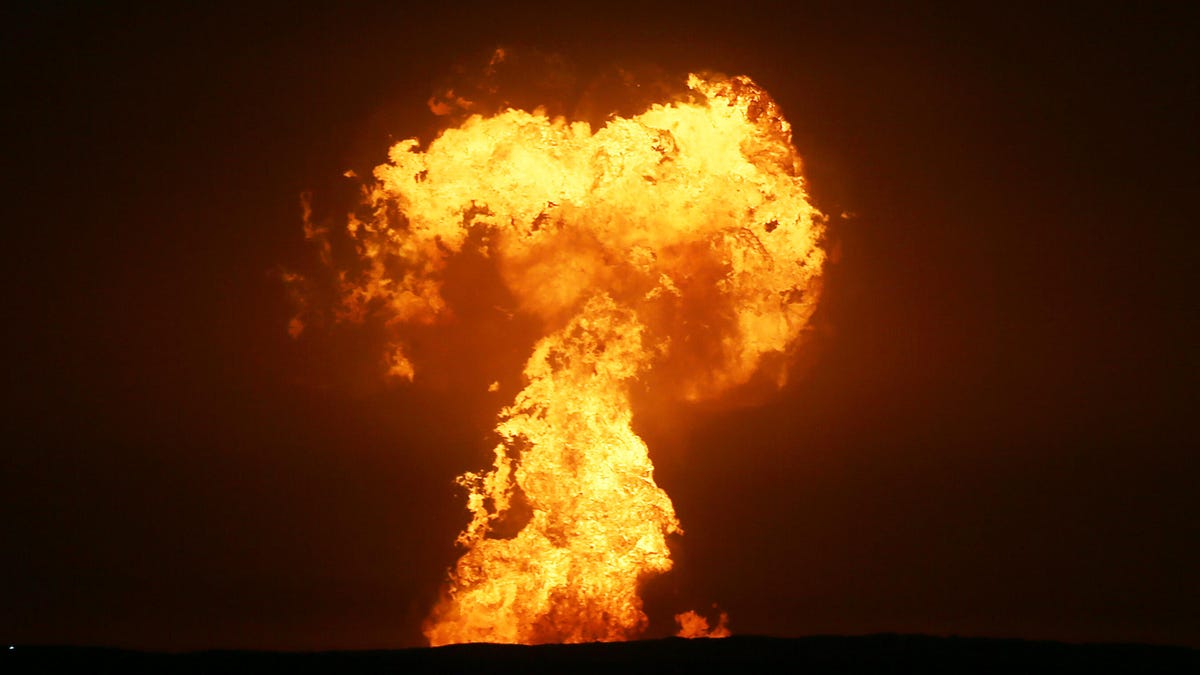'The ocean is on fire again': Mud volcano explodes, lighting up the Caspian Sea
An eruption south of the Azeri capital sent fire streaming into the night sky on Sunday. A mud volcano has been pinned as the culprit.

On July 4, an explosion rocked the Caspian Sea, off the shoreline of Azerbaijan.
An explosive jet of fire, believed to be caused by a mud volcano, lit up the Caspian Sea on Sunday according to a report by the APA, an Azerbaijani press agency. The fire occurred about 6 miles from the Umid gas field, south of Baku, the Azerbaijani capital.
The State Oil Company of Azerbaijan Republic (SOCAR) told the APA none of its oil platforms were affected by the incident. No injuries have been reported.
"There have been no accidents on offshore platforms and industrial facilities under the direct control of SOCAR, and work is continuing normally," said Ibrahim Ahmadov, deputy head of SOCAR's public relations and events department, speaking to the APA.
It's the second time in two days a fiery water incident has been detailed. On July 2 an underwater pipeline leaking gas into the Gulf of Mexico set the surface of the ocean ablaze sending social media spiralling with proclamations that the "ocean is on fire." On Sunday, "the ocean is on fire again" echoed throughout the Twittersphere. (The Caspian Sea is an inland sea so... okay, let's not get into it.)
This explosion appears to be natural. Speaking to the APA, Azerbaijani seismologist Gurban Yetirmishli suggests the fire is indicative of a mud volcano. This wouldn't be a surprise: The region is home to hundreds of mud volcanoes.
"Azerbaijan has basically the perfect geological conditions for mud volcanoes," said Mark Tingay, a geophysicist from the University of Adelaide in Australia, who has meticulously recorded the locations of mud volcanoes around the world.
Like their more familiar, lava-filled cousins, sometimes mud volcanoes erupt. But what are they and how can they catch fire?
What is a mud volcano?
A mud volcano is exactly as the name suggests: a volcano that erupts with muddy fluids, rather than lava. That means they're not exactly real volcanoes (but let's not get into that debate).
They are caused by water being heated deep within the Earth and mixing with rocks and minerals to create a slurry that is then forced up to the surface via fissures or cracks. Tingay explains in a comprehensive Twitter thread from 2019 they can range from being "tiny cute features" measuring just a few centimeters across to "huge things that are several hundred meters high and kilometres wide."
If they happen to be near something like an oil field, they might be "plumbed" into oil and natural gas systems. When they erupt, the oil and gas -- flammable substances -- spew into the sky with the mud. It's unclear exactly how they might ignite, but the pressure change or sparks in the mud caused by rocks smashing into each other during an eruption could explain the fireballs, Tingay notes.
Tingay analyzed the Caspian Sea explosion and speculated, based on some of the footage, that it could be a mud volcano known as Makarov Bank. That would have been interesting -- in 1958, this mud volcano exploded, launching a fireball 500 meters into the sky.
But based on further analysis, Tingay also specualted about two other potential candidates which are close to the Umid oil field. Both lined up with video footage and thermal anomalies detected by the National Oceanic and Atmospheric Administration: The Ignatiy Stone Bank mud volcano (also known as Dashly Island) and the Kumany Bank mud volcano.
By Monday morning, confirmation came in the form of a flyover:
UPDATE: Confirmation!!!
— Mark Tingay (@CriticalStress_) July 5, 2021
Morning footage of mud eruption on Dashly Island, also known as Ignatiy Stone Bank, mud volcano. https://t.co/J4CZ4ZubdQ
A ship has been sent to the scene to investigate and Ahmadov, from SOCAR, says "the public will be informed as soon as there is additional information."
Update July 5: Adds confirmation about mud volcano at Dashly Island

